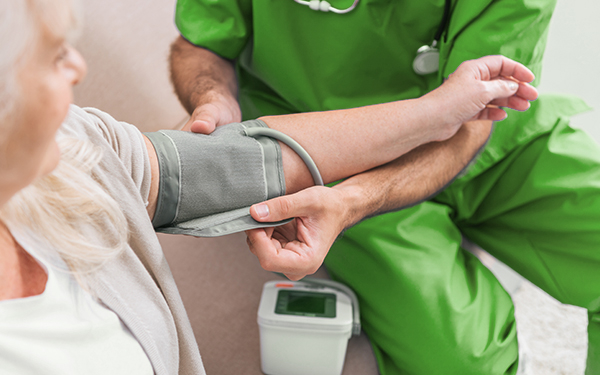Blood Pressure
High blood pressure (aka hypertension) is a silent epidemic that threatens the lives of one in every three adults in America. Since hypertension is a major risk factor for stroke, heart disease, congestive heart failure, and kidney disease, it acts as an accomplice in millions of additional deaths each year.
Blood pressure is a measurement of the force exerted by blood as it is pumped through the arteries. The heart’s contraction creates systolic pressure, and its relaxation causes diastolic pressure. This alternation in pressure occurs with every heartbeat – from 60-80 times every minute in the average adult. Clinically, these measurements are expressed in millimeters of mercury (mmHg) as systolic over diastolic pressure. For instance, 120/80 mmHg is considered normal. High blood pressure occurs when there is an increase in this force with potentially damaging consequences.
Symptoms & Diagnosis
In any closed plumbing system, pressure is maintained by the interaction of the pump, the pipes, and the fluid. In our bodies, the pump is the heart; the pipes are our blood vessels; and the fluid is our blood. When one element is affected, the others must follow suit, and our bodies use a complex system of mechanisms to keep the system in check. There are three ways to decrease pressure in this system: slow down the pump, make the pipes bigger, or decrease the amount of fluid. Steady long-term pressure is effortlessly maintained while still allowing short-term changes in times of stress or exercise.
Understanding the previous plumbing analogy can help to visualize the causes of hypertension and why it can be a serious health problem.
- The pump (aka heart) increases force or rate during exercise or stress. Naturally, a heart doing this for a prolonged time can be problematic.
- Aging or hormonal changes can cause decreased flexibility or diameter of the pipes (aka blood vessels). Sustained high pressure for long periods can damage the vessels and the organs supplied by them. Stroke, kidney disease, aneurysm, and vision loss are only a few examples.
- Regulation of fluid amount by the kidneys is influenced by a delicate balance of hormones.
Medical Treatment
Conventional medical management of hypertension begins with one or more antihypertensive drug therapies to achieve a target blood pressure goal of less than 140/90 mmHg through at-home blood pressure monitoring and regular healthcare visits. Antihypertensive drugs lower blood pressure by affecting one or more of the elements in the system – the pump, the pipes, or the fluid. The most widely prescribed drugs can be grouped into these three categories:
- Those affecting the pump: Cardioinhibitory drugs (such as beta blockers and calcium channel blockers) decrease blood pressure by reducing the rate and/or force with which the heart contracts. These drugs may exacerbate depression, headache, swelling of the ankles and feet, flushing of the face and neck, erectile dysfunction, sleep disturbances, fatigue, dizziness, and skin rash.
- Those affecting the pipes: ACE inhibitors, renin inhibitors, alpha blockers, and angiotensin receptor blockers (ARBs) are vasodilator drugs which cause increased blood vessel diameter and decreased fluid volume by water excretion from the kidneys. Frequent side effects of these drugs include dizziness, fatigue, weakness, headache, diarrhea, flu-like symptoms, and persistent dry cough. Emerging evidence suggests that some of these drugs may cause severe intestinal problems resembling celiac disease.
- Those affecting the fluid: Diuretic drugs cause fluid loss through increased kidney activity. Adverse effects of thiazide diuretics include sexual dysfunction, glucose intolerance, gout, low potassium levels, and low sodium levels. Conventional treatments often overlook the depletion of vital magnesium that can be caused by diuretics.
In the world of medicine, advancing age, gender, family history, and genetic predisposition are considered the main contributors to high blood pressure. These risk factors are impossible to modify, but other risk factors can easily be modified through preventive action. These include nutritional deficiencies, obesity, insulin resistance, chronic stress, sedentary lifestyle, smoking, and excess alcohol.
Unfortunately, mainstream medicine has fallen hopelessly short of properly addressing hypertension due to an inability to effectively modify these previously mentioned factors. Therefore, effective management is rarely achieved through a single drug intervention, and additional drugs are then prescribed. This frequently results in patients taking multiple hypertensive medications yet still experiencing high blood pressure. They then carry an incessant fear of high blood pressure leading to their demise while they repeatedly monitor numbers to no avail.

Weight management, increased physical activity, limitation of alcohol consumption, dietary modification, and nutritional supplementation are among the best studied and most effective lifestyle changes for blood pressure management. These approaches aim to balance favorable nutrient intake to enhance the body’s natural pressure regulation. Likewise, dietary increases in plant protein and soluble fiber can positively affect mineral absorption, insulin sensitivity, and natural kidney excretion of sodium and water. Research also suggests caloric restriction to slow down the body’s growth processes, causing a focus on protective repair mechanisms resulting in blood pressure reductions.
Nutritional therapies to manage hypertension mirror many of the strategies of traditional pharmaceutical approaches minus the side effects. Specific dietary compounds and nutritional supplementation are widely known to support cardiovascular health while naturally and significantly lowering blood pressure.
At Divine Design Natural Health, dietary changes elicit effective and long-lasting results in lowering and maintaining a healthy blood pressure. Cold laser therapy, detoxification, and chiropractic adjustments address the removal of toxins known to elevate blood pressure while stimulating the nervous system to regulate blood flow safely. All of our methods stimulate blood flow and thereby affect the body systemically, allowing your innate healing capacity to override the need for pharmaceutical dependence.



